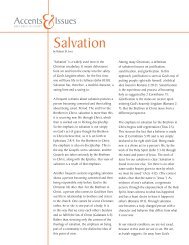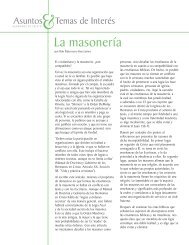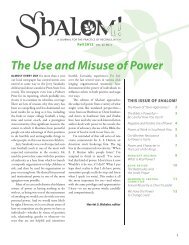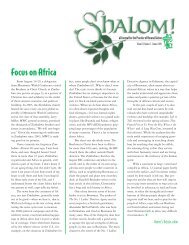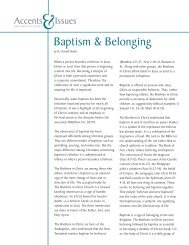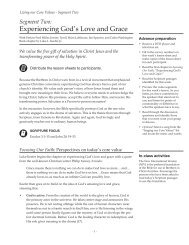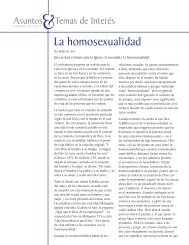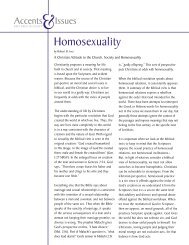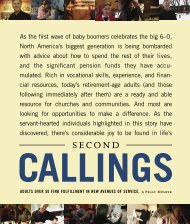Summer 2009 - Brethren in Christ Church
Summer 2009 - Brethren in Christ Church
Summer 2009 - Brethren in Christ Church
You also want an ePaper? Increase the reach of your titles
YUMPU automatically turns print PDFs into web optimized ePapers that Google loves.
INPARTTHE MAGAZINE FOR THE BRETHREN IN CHRIST COMMUNITY IN NORTH AMERICA <strong>Summer</strong> <strong>2009</strong>
INPART<strong>Summer</strong> <strong>2009</strong> volume 122 Number 3THE MAGAZINE FOR THE BRETHREN IN CHRISTCOMMUNITY IN NORTH AMERICABRETHREN IN CHRIST CHURCHModerator: Warren L. HoffmanGeneral Secretary: Don McNivenDirector of Congregational Relations:Rebekah Burch Bas<strong>in</strong>gerEditor: Krist<strong>in</strong>e N. FreyGraphic Designer: Nate Bridi431 Grantham Road, PO Box AGrantham, PA 17027-0901Telephone: (717) 697-2634Fax: (717) 697-7714FEATURES6One <strong>Christ</strong>ian to another→Redef<strong>in</strong><strong>in</strong>g church discipl<strong>in</strong>e for the21st centuryby david weaver-zercher<strong>in</strong>part.org (issn 1940-2945)IN PART (ISSN 1940-2937) is publishedfour times a year by the <strong>Brethren</strong> <strong>in</strong> <strong>Christ</strong><strong>Church</strong> of North America. In Part <strong>in</strong>vitesreaders <strong>in</strong>to a dynamic relationship withJesus <strong>Christ</strong> with<strong>in</strong> the context of theshared life and m<strong>in</strong>istry of the BIC <strong>Church</strong>.Pr<strong>in</strong>ted by Evangel Press, Nappanee, Ind.Send feedback, address changes, or subscriptionquestions to <strong>in</strong>part@bic-church.org.Postmaster: Send changes of address to:IN PART431 Grantham Road, PO Box AGrantham, PA 17027-0901Periodical Postage Paid at Nappanee, IN46550-0166.Pr<strong>in</strong>ted <strong>in</strong> U.S.A.Member of the Evangelical Press Association.Biblical quotations, unless otherwise <strong>in</strong>dicated,are from the New International Version.Copyright © <strong>2009</strong>. All rights reserved.Pr<strong>in</strong>ted on FSC-certified Domtart Opaque-Pla<strong>in</strong>field paper. At least 25% of the paperfiber comes from well-managed forests<strong>in</strong>dependently certified accord<strong>in</strong>g to the rulesof the Forest Stewardship Council; 10% isrecycled from post-consumer waste paper.10Speak<strong>in</strong>g the (straight)truth <strong>in</strong> (authentic) love→Pacific Lifel<strong>in</strong>e changes lives throughaccountability and graceby susan k. gettyDEPARTMENTS 24In Motion→ Mak<strong>in</strong>g “The Difference” ·New life <strong>in</strong> New Mexico ·Reach<strong>in</strong>g out to the recicladores· Women at the wellPART OF THE WHOLE→ At home with communityby lisa brown5 to our core→ When form follows faithby e. morris sider141617Vibes→ Eat, weed, and be merryby sarah imbodenTO THE POINT→ <strong>Church</strong> membership andaccountabilityby john arthur brubaker, tim day,peter h. von keyserl<strong>in</strong>g, &esther spurrierPARTING WORDS→ The graffiti man ofCollege Parkby perry englestay connected through“family news,”a quarterly publication that chronicles thebirths, wedd<strong>in</strong>gs, anniversaries, and deathswith<strong>in</strong> the BIC family <strong>in</strong> North America. Visitbic-church.org/family or call 717.697.2634to subscribe or to submit news items.summer <strong>2009</strong>
<strong>in</strong> partIN MOTIONstories of the bic <strong>in</strong> actionmak<strong>in</strong>g“the difference”“After 33 years of m<strong>in</strong>istry <strong>in</strong> establishedchurches, you tend to becomeaccustomed to do<strong>in</strong>g th<strong>in</strong>gs a certa<strong>in</strong>way,” observes Calv<strong>in</strong> Hambl<strong>in</strong>, pastorof The Difference BIC, a churchplant <strong>in</strong> Massillon, Ohio. But as Calobserves, his work with the fledgl<strong>in</strong>gchurch has changed that: “<strong>Church</strong>plant<strong>in</strong>g requires a high degree offlexibility and spontaneity. I’m learn<strong>in</strong>gto go with the flow and not be sodependent upon my own ability tobr<strong>in</strong>g th<strong>in</strong>gs to pass.”Formerly the pastor at AmherstCommunity BIC (Massillon, Ohio),Cal led the 17-member core groupthat founded The Difference—whichmeets at a local elementary school—<strong>in</strong> May 2008, and the church heldits launch Sunday <strong>in</strong> October 2008.From hand<strong>in</strong>g out bottled waterat local athletic events to scoop<strong>in</strong>gfree ice cream <strong>in</strong> nearby neighborhoods,Cal and his team have beenactively promot<strong>in</strong>g the new fellowshipto everyone they meet.“The real key to our outreach hasbeen the <strong>in</strong>tentional efforts of thecongregation to cultivate relationshipswith neighbors, co-workers, andfriends <strong>in</strong> order to <strong>in</strong>vite them to‘jo<strong>in</strong> the family,’” he says. “We believethis is the heart of our outreach.”√ InPart Onl<strong>in</strong>e:Follow the unfold<strong>in</strong>g story of The DifferenceDev<strong>in</strong> ThomasBIC Communications InternMembers of The Difference spread word about the∆ church plant at the Massillon (Ohio) FunFest.New life <strong>in</strong> New MexicoIn January 2008, Kip Vaughn beganpray<strong>in</strong>g for God to provide three tofive new families to Sandia ChapelBIC, the church he pastored <strong>in</strong>Albuquerque, N.M. Sandia firstopened its doors <strong>in</strong> the early 1950s,but half a century later, the churchwas <strong>in</strong> decl<strong>in</strong>e as it struggled to adaptto a chang<strong>in</strong>g neighborhood.Meanwhile, Desert Light <strong>Christ</strong>ian<strong>Church</strong> was a young, vibrant, nondenom<strong>in</strong>ationalchurch plant. As EricVillanueva, who was serv<strong>in</strong>g as the pastorthere, expla<strong>in</strong>s, the thriv<strong>in</strong>g congregationhad “all the pieces <strong>in</strong> place, butneeded a place to do the pieces.”All of this changed when Eric andKip met through the AlbuquerqueRescue Mission and began discuss<strong>in</strong>gthe potential for a church merger. InJuly 2008, just two months later, SandiaChapel BIC became Desert Light<strong>Christ</strong>ian <strong>Church</strong> (BIC), and bothchurches found their prayers answered.“We at Desert Light had constantlycried out for a place to meet, but alsoneeded to belong to a denom<strong>in</strong>ation∂ PHOTO: Courtesy of Calv<strong>in</strong> Hambl<strong>in</strong>Eric Villaneuva (left) and Kip Vaughn pastor the∆ rejuvenated Desert Light <strong>Christ</strong>ian <strong>Church</strong> (BIC).whose values we shared and withwhich we could grow together,” statesEric, who now shares pastoral responsibilitieswith Kip. “The BIC becamethat for us.”Today, Desert Light <strong>Christ</strong>ian<strong>Church</strong> is a diverse body of people ofvarious ethnicities, ages, and culturescommitted to outreach. A focuson family m<strong>in</strong>istry is result<strong>in</strong>g <strong>in</strong>couples com<strong>in</strong>g to <strong>Christ</strong> and savedmarriages, while efforts to serve childrenand men are also flourish<strong>in</strong>g.Most recently, Desert Light<strong>Christ</strong>ian <strong>Church</strong> leadership <strong>in</strong>itiated“100 × 2”—a vision that after 100people fill the sanctuary two times,they will beg<strong>in</strong> a new service or churchplant. Currently, they are look<strong>in</strong>gto add a service <strong>in</strong> Spanish. As Kipstates <strong>in</strong> his annual report for 2008,“Who would have dreamed that wewould be where we are today?Praise His Mighty name! The bestis yet to come!”Kelly FunkPalmyra (Pa.) BIC∂ PHOTO: Courtesy of Kip VaughnIN PARTINPART.ORG
IN MOTIONMany recicladores <strong>in</strong> Bogotá, Colombia, live <strong>in</strong> humble conditions and are rejected from ma<strong>in</strong>stream culture,∆ a trend that Trevor Ma<strong>in</strong>, a BICWM missionary there, is work<strong>in</strong>g to change.Reach<strong>in</strong>g out to the recicladoresThey can be seen <strong>in</strong> the streets ofBogotá, Colombia, late <strong>in</strong>to thenight, scour<strong>in</strong>g dumpsters and publictrash cans for discarded items, whichthey pile onto horse- or humandrawncarts and carry off to sell orre-use. They’re known as recicladores(“recyclers”), and they make a liv<strong>in</strong>gby recycl<strong>in</strong>g the plastics, glass, cardboard,and paper that so many otherssimply throw away. But unfortunately,the weaken<strong>in</strong>g global economyhas caused the value of the materialsthey sell to plummet, mak<strong>in</strong>g theirpoverty even more pronounced.“People who do this work arerejected and stay pretty much segregatedfrom the rest of society,” TrevorMa<strong>in</strong>, a BICWM missionary serv<strong>in</strong>g<strong>in</strong> Colombia, expla<strong>in</strong>s. But Trevoris work<strong>in</strong>g to challenge the socialstigma surround<strong>in</strong>g the recicladoresby coord<strong>in</strong>at<strong>in</strong>g efforts to reach outto a nearby community of workers.Every third Saturday of the month,he and his family jo<strong>in</strong> with a fewpeople from Tierra L<strong>in</strong>da—a BICchurch <strong>in</strong> the capital city of Bogotá—and from his son’s high school tovisit the recicladores’ shantytown.While there, the group shares Biblestories, plays games, does crafts, s<strong>in</strong>gs,and has snacks with about 25 childrenwho live there. Dur<strong>in</strong>g the off-weeks,some also return to learn whichchildren come from which homes andget to know their families. In December,Tierra L<strong>in</strong>da <strong>in</strong>vited the kids to a<strong>Christ</strong>mas party at the church, whereeach received presents donated bychurch members. Trevor reports that“generous gifts from BIC <strong>in</strong>dividuals<strong>in</strong> North America,” have also madeit possible to provide school kits tochildren and to distribute bread andmilk to the whole community.“It’s been excit<strong>in</strong>g to see God touch<strong>in</strong>g<strong>Christ</strong>ians’ hearts at Tierra L<strong>in</strong>dato reach out with the love of <strong>Christ</strong>to a community that has largely beenoverlooked and neglected,” he shares.√ InPart Onl<strong>in</strong>e:Watch Trevor’s video about the recicladores∂ PHOTO: Courtesy of Trevor Ma<strong>in</strong>women at the wellThis past March, 66 women serv<strong>in</strong>g<strong>in</strong> all levels of m<strong>in</strong>istry with<strong>in</strong> theBIC <strong>Church</strong> gathered at KenbrookBible Camp (Lebanon, Pa.) for“Women at the Well: Choos<strong>in</strong>g whatis better,” the fifth biennial retreatof the BIC Council for Women <strong>in</strong>M<strong>in</strong>istry and Leadership. Over thethree-day conference, participantsreflected on Luke 10:42, the themeverse, as they attended workshopson a variety of subjects, <strong>in</strong>clud<strong>in</strong>gbiblical foundations for women <strong>in</strong>m<strong>in</strong>istry, observ<strong>in</strong>g the Sabbath, and<strong>in</strong>corporat<strong>in</strong>g the arts <strong>in</strong> worship.In addition to those fromRegional Conferences across NorthAmerica, three attendees came fromBIC sister churches <strong>in</strong> the UnitedK<strong>in</strong>gdom. “This was the second timethat we had the opportunity to hostwomen serv<strong>in</strong>g <strong>in</strong> leadership positions<strong>in</strong> BIC churches outside ofNorth America,” notes Lois Saylor,assistant chair of the Council. “It isalways excit<strong>in</strong>g and worthwhile toadd this global dimension to the textureand conversation of the retreat.”Rosett Sibona-Moyo, a m<strong>in</strong>istryleader at Southendon-Sea BIC<strong>Church</strong> <strong>in</strong> Essex, U.K., first heardabout the retreat from her pastor and,after receiv<strong>in</strong>g a scholarship from theCouncil, was able to attend. “I enjoyedthe retreat, especially the discussionsabout the challenges encountered bywomen <strong>in</strong> leadership,” she says.summer <strong>2009</strong>
<strong>in</strong> partPART OF THE WHOLEfocus<strong>in</strong>g on one couples’s faithat home with communityFor Mike and Melri Wright, family life and m<strong>in</strong>istryboth happen under one roofby Lisa BrownIn 1988, as a young adult, MikeWright jo<strong>in</strong>ed YouthBuilders, ayear-long m<strong>in</strong>istry team that traveledto churches throughout Ontario towork with their youth m<strong>in</strong>istries.“I grew up outside the BIC <strong>Church</strong>and had never experienced the k<strong>in</strong>dof love, conflict-resolution, accountability,<strong>in</strong>spiration, and challengethat I found with YouthBuilders,” hesays. And it was this experience thathelped lead Mike to the <strong>Brethren</strong> <strong>in</strong><strong>Christ</strong> <strong>Church</strong> and, eventually, tothe Centre for Student Leadership(Clarksburg, ON), where he and hiswife, Melri, have lived and served asdirectors for the last six years.The ma<strong>in</strong> purpose of the Centrefor Student Leadership (CSL) is toprovide m<strong>in</strong>istry opportunities andtra<strong>in</strong><strong>in</strong>g for young adults, especiallythose tak<strong>in</strong>g part <strong>in</strong> BIC programslike YouthBuilders. Mike, who alsoserves as associate for the CanadianConference’s Student M<strong>in</strong>istry team,facilitates this by mentor<strong>in</strong>g participantsand provid<strong>in</strong>g special <strong>in</strong>structionon liv<strong>in</strong>g <strong>in</strong> community dur<strong>in</strong>gthe team’s time together.“Jesus lived <strong>in</strong> close communitywith His disciples, and His exampleis what motivates and <strong>in</strong>spires Melriand me to engage student teams <strong>in</strong> a24/7 communal experience,” he states.In addition to host<strong>in</strong>gyoung adults, Mike, Melri,and their two childrenwelcome other groups totheir home at the Centrethroughout the year.Although liv<strong>in</strong>g <strong>in</strong> constantcommunity can bechalleng<strong>in</strong>g, Mike saysthat the tension <strong>in</strong> the home-worksituation has been m<strong>in</strong>imal. “Hav<strong>in</strong>ggroups come to where we live to doretreats feels natural and normal toour family,” he says. His children lookforward to meet<strong>in</strong>g people who visit,and he and Melri have discoveredunique ways to keep their marriagehealthy: “We also hold each otheraccountable to both our marriageand our m<strong>in</strong>istry, and we place a highvalue on daily contact and communicationabout joys and struggles.”Community and accountabilityplay a part <strong>in</strong> all of Mike’s roles atthe Centre, but he notes that theyare “experienced most fully andcompletely” with his fellow CSLteam members.Composed of three core couplesand a few <strong>in</strong>ternss from acrossdenom<strong>in</strong>ations, the team connectson a regular basis (sometimes daily)and meets for <strong>in</strong>tense times of communalliv<strong>in</strong>g throughout the year.∂Mike and Melri Wright participate <strong>in</strong> community life <strong>in</strong> their homeat the Centre for Student Leadership, as well as at their church,New Life BIC (Coll<strong>in</strong>gwood, ON).“These periods of communal liv<strong>in</strong>gforce us to open our lives up moreand more, extend<strong>in</strong>g <strong>in</strong>to areas of ourlife that most leave shadowed. We areopen to challeng<strong>in</strong>g each other onareas of family, f<strong>in</strong>ances, future lifedecisions, and spiritual development,”Mike says. “This has encouraged meto open up areas of my life that I’vealways thought were the exclusivedoma<strong>in</strong> of my family. I am becom<strong>in</strong>gmore open with others about everyarea of my life so that we can <strong>in</strong>terdependentlyshare burdens, feedback,and support.”And this, accord<strong>in</strong>g to Mike, iswhat community is all about.Lisa Brown is a freelance writer whoattends The Meet<strong>in</strong>g House and lives<strong>in</strong> Oakville, ON, with her husband,Kev<strong>in</strong>, and their daughter. As moviefanatics, Lisa and Kev<strong>in</strong> see as manyas they can <strong>in</strong> the theatre every year.∂ PHOTO: Courtesy of Mike WrightIN PARTINPART.ORG
TO OUR COREexplor<strong>in</strong>g the central values of the bic churchwhen formfollows faithHow the architecture of oneBIC meet<strong>in</strong>g house revealsan historic commitment ofthe <strong>Church</strong>by E. Morris SiderFor the first 100 years of <strong>Brethren</strong> <strong>in</strong><strong>Christ</strong> history, members met <strong>in</strong>each other’s homes as testimony totheir commitment to simplicity andfamily-like community. Then, <strong>in</strong>the 1870s, to accommodate theirgrow<strong>in</strong>g numbers, our BIC ancestorsbegan gather<strong>in</strong>g <strong>in</strong> meet<strong>in</strong>g houses—build<strong>in</strong>gs constructed specifically forworship. In these new sett<strong>in</strong>gs, the valuesof community and accountabilitythat come with family life at its bestrema<strong>in</strong>ed strong, and the meet<strong>in</strong>ghouses’ architecture was an extensionof those theological commitments.Look<strong>in</strong>g at the R<strong>in</strong>ggold Meet<strong>in</strong>gHouse, which was built <strong>in</strong> Maryland<strong>in</strong> 1871 and is one of the oldest still<strong>in</strong> existence, we can see how theseearly BIC lived out the call to accountability<strong>in</strong> various areas of faith.Accountability to liv<strong>in</strong>g simply:The simple structure, bare walls andceil<strong>in</strong>g, and pla<strong>in</strong>, unpadded pewsof the R<strong>in</strong>ggold Meet<strong>in</strong>g Houseillustrate the unadorned constructionand décor of early BIC church build<strong>in</strong>gs.This austerity rem<strong>in</strong>ded attendeesof the worthlessness of earthlywealth and the call to modest liv<strong>in</strong>g.≥ We value <strong>in</strong>tegrity <strong>in</strong> relationships and mutual accountability<strong>in</strong> an atmosphere of grace, love, and acceptance.Accountability to purity: Typical ofall early meet<strong>in</strong>g houses, the R<strong>in</strong>ggoldMeet<strong>in</strong>g House has two separateentrances, one for men and one forwomen and children. It also had apartition runn<strong>in</strong>g between the twosides of the room. Both of these measuressought to separate members ofthe opposite sex and thus elim<strong>in</strong>atedistractions so that full attentioncould be given to the Word.Accountability to God and eachother: Unlike most churches today,the R<strong>in</strong>ggold Meet<strong>in</strong>g House featuresa floor-level pulpit table. Thissymbolized the idea of the fellowshipof believers and suggested thatm<strong>in</strong>isters were not elevated abovethe congregants, either <strong>in</strong> terms oftheir access to God’s truth or theirfreedom from s<strong>in</strong> and weaknesses.It was a visual demonstration thatcongregants were responsible to holdthe m<strong>in</strong>isters accountable, just as them<strong>in</strong>isters were to guide the flock andhold its members accountable.Accountability to humility: Theoffer<strong>in</strong>g box, which was located atthe meet<strong>in</strong>g house’s entrance, harkensback to a time when <strong>Brethren</strong><strong>in</strong> <strong>Christ</strong> did not “lift” offer<strong>in</strong>gs bymeans of offer<strong>in</strong>g plates, as they donow. Rather, offer<strong>in</strong>gs were deposited<strong>in</strong> the offer<strong>in</strong>g box quietly and<strong>in</strong> private. This helped congregantsrema<strong>in</strong> humble <strong>in</strong> their giv<strong>in</strong>g toGod and His k<strong>in</strong>gdom.BIC church build<strong>in</strong>gs today come<strong>in</strong> all shapes and sizes, and most lookvery different from the R<strong>in</strong>ggoldMeet<strong>in</strong>g House. I wonder what ourdescendants 100 years from now willsurmise about our theology by look<strong>in</strong>gat our meet<strong>in</strong>g spaces.Adapted from “The R<strong>in</strong>ggold Meet<strong>in</strong>g House as Symbol” byE. Morris Sider <strong>in</strong> the December 1995 issue of <strong>Brethren</strong> <strong>in</strong><strong>Christ</strong> History and Life.E. Morris Sider is the editor of the BICHistorical Society and has penned anumber of books and articles on BIClife. He is professor emeritus of historyand English literature at MessiahCollege (Grantham, Pa.). He and his wife, Leone, arelongtime members of the Grantham BIC congregation.summer <strong>2009</strong>
Illustration by Gregory Snader
few years ago, I had a conversation with a friendabout church discipl<strong>in</strong>e. This friend—a committed<strong>Christ</strong>ian and a faithful churchgoer—admitted that hefound the idea of church discipl<strong>in</strong>e outdated. “There’s onlyone k<strong>in</strong>d of discipl<strong>in</strong>e that’s relevant <strong>in</strong> the North American<strong>Church</strong> today, and that’s self-discipl<strong>in</strong>e,” he said. Hispo<strong>in</strong>t, if I understood him correctly, was that, rather than<strong>in</strong>stitut<strong>in</strong>g corporate policies and practices that call peopleto account, church leaders should devote their energies tohelp<strong>in</strong>g <strong>in</strong>dividuals develop spiritual practices and moralconvictions that serve to discipl<strong>in</strong>e their own lives.I couldn’t tell if my friend lamented this situation ornot. Did he th<strong>in</strong>k that discipl<strong>in</strong>ary procedures were themselvesa problem? Or were my friend’s observations simplypragmatic, based upon the assumption that corporatediscipl<strong>in</strong>e was no longer practical, given the way churchlife functions <strong>in</strong> contemporary North America?I suspect it was the latter, and for good reason. Nearlyeveryone who studies long-term trends <strong>in</strong> North Americanchurch life will tell you that a consumerist orientationhas more or less won the day, particularly <strong>in</strong> Protestantcircles. The fact of the matter is this: North Americanchurches compete with one another for adherents, andmany adherents choose a particular church based on thegoods and services they f<strong>in</strong>d there. That’s not to suggestthat these adherents don’t contribute anyth<strong>in</strong>g to theirchurches; it’s rather to say that, <strong>in</strong> the process of mak<strong>in</strong>gthose contributions, most churchgoers conduct an <strong>in</strong>formalcost-benefit analysis. If the costs are too high andthe benefits too low, they will likely start to shop around.This market analogy sounds crass, Iknow, but my own experience bearsit out. A year ago my wifeand I left one church,and we now attend another. Although the process ofleav<strong>in</strong>g our former church was emotionally wrench<strong>in</strong>g,we were ultimately attracted to our new church becauseof its perceived benefits: Not only was it nearer to ourrecently purchased home, but it offered theologicalemphases we valued, a worship style we enjoyed, andready-made peer groups for our pre-adolescent sons.Chang<strong>in</strong>g churches once <strong>in</strong> a 10-year span may not makeme a pathological church shopper, but compared to mygrandfather—who was born, baptized, and buried <strong>in</strong> thecontext of one congregation—I’m a ready participant <strong>in</strong>America’s religious marketplace.<strong>Church</strong> discipl<strong>in</strong>e <strong>in</strong> a religious marketplaceWhether we like it or not, this marketplace analogyhas real implications for how we th<strong>in</strong>k about discipl<strong>in</strong>e<strong>in</strong> the <strong>Church</strong> today.Traditional models of discipl<strong>in</strong>e as practiced by <strong>Brethren</strong><strong>in</strong> <strong>Christ</strong> congregations <strong>in</strong> the past were developeddur<strong>in</strong>g a time when churches were more ak<strong>in</strong> to familiesthan marketplaces. Th<strong>in</strong>k about a family: Not only is afamily comprised of relatively few people, but the membersare “familiar” with one another. Moreover, unlike ourfavorite stores and restaurants, families are not someth<strong>in</strong>gwe choose. We may not appreciate everyth<strong>in</strong>g about ourfamilies, but we don’t typically go shopp<strong>in</strong>g for anotherone. In fact, ongo<strong>in</strong>g connections with family membersare assumed, and it’s considered tragic if those connectionsare broken—much more tragic than if we breakour ties with our favorite home improvement store.To be sure, most of you read<strong>in</strong>g these words are morecommitted to your local churches than you are to HomeDepot or Lowe’s. Still, it’s possible that your local churchis more ak<strong>in</strong> to your favorite store than it is to yourbiological family. And that means traditional discipl<strong>in</strong>arypractices don’t work very well, because consumers, when
One <strong>Christ</strong>ian to anothertold they are wrong, are more than happy to take theirbus<strong>in</strong>ess elsewhere. As one pastor recently told me, “It’shard to enact discipl<strong>in</strong>e when the church down the streetis happy to receive one more member.”The Old Order Amish and church discipl<strong>in</strong>eThere is, of course, one North American <strong>Church</strong> thatcont<strong>in</strong>ues to function <strong>in</strong> opposition to the religious marketplace.The Old Order Amish, who, as Anabaptists, sharetheological roots with the <strong>Brethren</strong> <strong>in</strong> <strong>Christ</strong> <strong>Church</strong>,function much more like a family than shoppers <strong>in</strong> a<strong>Christ</strong>ians, if they are to flourishspiritually, need people <strong>in</strong> theirlives who ask prob<strong>in</strong>g questionsand offer honest counsel.department store. Their local churches are small, and thepeople who attend them know each other well. It’s not unusualfor persons to be born <strong>in</strong>to, to receive baptism, andto live out their entire lives <strong>in</strong> a particular Amish congregation.S<strong>in</strong>ce Amish congregations are geographically based,Amish people aren’t allowed to transfer their membership.Choice may be the hallmark of consumer capitalism, but ithas not yet made its way <strong>in</strong>to the Amish <strong>Church</strong>.Whether you hold the Amish <strong>in</strong> high or low regard,it’s hard to deny the potency of Amish discipl<strong>in</strong>ary practices.This potency flows from four factors:1. The Amish have a clear set of shared standards, calledthe Ordnung. The Ordnung is not typically writtendown, but church members are keenly aware of itscontents and, at baptism, they vow to keep theseregulations for life.2. The Amish have a will<strong>in</strong>gness to enforce these standards.Although there may be exceptions, Amish churchleaders vigorously embrace the responsibility toenforce their district’s Ordnung. If the bishops don’tenforce the Ordnung, then the jig is up, and thecommunity will soon cease to be Amish.3. The Amish have a deep familiarity with their fellowchurch members. One of my friends who converted tothe Amish said the hardest part was not giv<strong>in</strong>g up hiscar, but rather his privacy. M<strong>in</strong>d<strong>in</strong>g one’s own bus<strong>in</strong>essmay be a virtue <strong>in</strong> some circles, but if you’re Amish,you’re supposed to m<strong>in</strong>d other people’s bus<strong>in</strong>ess.4. The Amish enact a form of discipl<strong>in</strong>e—shunn<strong>in</strong>g—thatis profoundly pa<strong>in</strong>ful to the wayward person. This ritualizedpractice of social distanc<strong>in</strong>g, which the Amishbase on I Cor<strong>in</strong>thians 5:9–13, varies from communityto community, but the goal is always the same: torestore the wayward person to the church. Shunn<strong>in</strong>gsometimes works, though its real power lies <strong>in</strong> thethreat of it, for it deters Amish people from establish<strong>in</strong>gtheir own set of rules for liv<strong>in</strong>g the <strong>Christ</strong>ian life.As far as I know, shunn<strong>in</strong>g has never been practiced <strong>in</strong>the <strong>Brethren</strong> <strong>in</strong> <strong>Christ</strong> <strong>Church</strong> (and I suspect most of usare grateful for that). But even if we leave shunn<strong>in</strong>g aside,I’m not conv<strong>in</strong>ced that contemporary <strong>Brethren</strong> <strong>in</strong> <strong>Christ</strong>churches demonstrate the other factors that make rigorousdiscipl<strong>in</strong>e possible <strong>in</strong> Amish communities. We may havea set of shared ethical standards, but that set is relativelym<strong>in</strong>imal; we don’t know our fellow church members verywell, especially if our churches are large; we tend not to putour noses <strong>in</strong>to “other people’s bus<strong>in</strong>ess”; and our churchleaders are often quite reluctant to enact discipl<strong>in</strong>e.But if traditional forms of church discipl<strong>in</strong>e requirethe sort of community that most North American<strong>Christ</strong>ians no longer <strong>in</strong>habit, what are we to do? Is selfdiscipl<strong>in</strong>eall we have left?Accountability as a complement to discipl<strong>in</strong>eGiven the perils <strong>in</strong>herent <strong>in</strong> this area, it’s tempt<strong>in</strong>g togive our full attention to the more impersonal (and oftenaffirmative) forms of <strong>Christ</strong>ian discipleship: preach<strong>in</strong>gand teach<strong>in</strong>g. These are crucial activities, and churchesand pastors are wise to devote their best efforts to them.Nonetheless, the New Testament assumes more personal,and at times confrontational, forms of correction.Consider Matthew 18, I Cor<strong>in</strong>thians 5, and Colossians3. These texts presume that the <strong>Church</strong> exists, at least <strong>in</strong>part, to correct those who go astray.IN PARTINPART.ORG
This is where the idea of mutual accountability comes<strong>in</strong>. Unlike traditional practices of church discipl<strong>in</strong>e,which conjure up notions of hierarchy and punishment,mutual accountability suggests the creation of close, egalitarianrelationships. Discipl<strong>in</strong>e is someth<strong>in</strong>g that parentsdo to children; accountability is someth<strong>in</strong>g that happensbetween brothers and sisters. Granted, church discipl<strong>in</strong>emay sometimes be necessary—for <strong>in</strong>stance, whena church leader engages <strong>in</strong> s<strong>in</strong>ful behavior that is widelyknown but goes unconfessed—yet for the range of practicalreasons already outl<strong>in</strong>ed, we see that it’s difficult toenact it <strong>in</strong> our contemporary context. Consequently, ourchurches would be better served by nurtur<strong>in</strong>g accountability,one <strong>Christ</strong>ian to another.In The Godbear<strong>in</strong>g Life, authors Kenda Creasy Deanand Ron Foster contend that <strong>Christ</strong>ians, if they are toflourish spiritually, need people <strong>in</strong> their lives who ask prob<strong>in</strong>gquestions and offer honest counsel. They suggest, therefore,that each of us should have a “mentor,” someone who“possesses more experience, spiritual maturity, accumulatedwisdom, or a comb<strong>in</strong>ation of all three than we do.” Thisperson helps us discern a “faithful life course.” Good mentors(<strong>in</strong> some traditions they are called “spiritual directors”)do not seek to create a “relationship of superiority,” butthey are prepared to offer guidance and gentle correction.Unlike traditional practices of churchdiscipl<strong>in</strong>e, mutual accountabilitysuggests the creation of close,egalitarian relationships.Dean and Foster also say that each <strong>Christ</strong>ian wouldbenefit from hav<strong>in</strong>g at least one “soul friend,” a fellowtraveler who we see more frequently than a mentor andwith whom we can be open and honest. In addition toask<strong>in</strong>g questions about our bad (or s<strong>in</strong>ful) habits andGod’s lead<strong>in</strong>g <strong>in</strong> our lives, a soul friend, write Deanand Foster, is someone with whom we can “share ourdeepest doubts, joys, long<strong>in</strong>gs, fears, dreams, confusion,[and] search<strong>in</strong>g.”Creat<strong>in</strong>g a culture of accountabilityTaken together, mentors and soul friends add up toaccountability. On one level, this understand<strong>in</strong>g of accountabilityis not far removed from my friend’s notionof self-discipl<strong>in</strong>e, for it won’t happen unless <strong>in</strong>dividualchurch members commit themselves to it. But churchescan—and some churches do—convey this expectationto their new members. And while participation <strong>in</strong> thesetypes of relationships may be hard to enforce, communicat<strong>in</strong>gthis expectation creates a culture <strong>in</strong> which peopleknow that their spiritual health depends on others.A few years ago, I heard a story about a <strong>Brethren</strong> <strong>in</strong><strong>Christ</strong> church <strong>in</strong> the 1940s. The person tell<strong>in</strong>g the storyremembered that, when he was taken <strong>in</strong>to membershipas a relatively young man, he was asked two questions:Are you will<strong>in</strong>g to forgive your brothers and sisters <strong>in</strong> thiscongregation? And are you prepared to ask others to forgiveyou? Forgiveness and accountability are different animals,of course. Still, it’s these k<strong>in</strong>ds of questions, asked at theproper time, that create expectations for what it means tolive an authentic <strong>Christ</strong>ian life.So perhaps we should try out two new questions <strong>in</strong> ourmembership classes: Are you will<strong>in</strong>g to meet with a spiritualmentor? Are you will<strong>in</strong>g to share you life with, and accept thecounsel of, a close <strong>Christ</strong>ian friend? It may be that questionslike these, asked at just the right time, are our best hope forfoster<strong>in</strong>g discipleship <strong>in</strong> the 21st century.IN PART Onl<strong>in</strong>e at <strong>in</strong>part.org:≥ See what David’s father, John E. Zercher,wrote about accountability <strong>in</strong> hiseditorials for The Evangelical Visitor≥ Learn how quiz team members keep eachother sharp≥ enter to w<strong>in</strong> a free copy of david’s book,amish grace: how forgiveness transcendedtragedyDavid Weaver-Zercher is chair of the Department of Biblical andReligious Studies at Messiah College (Grantham, Pa.). A lead<strong>in</strong>gexpert on the Amish community, David is the co-author of AmishGrace: How Forgiveness Transcended Tragedy (Jossey-Bass, 2007).He lives <strong>in</strong> Mechanicsburg, Pa., with his wife and three sons.Gregory Snader is a cartoonist, illustrator, and 2007 graduateof Messiah College (Grantham, Pa.). He lives <strong>in</strong> Lancaster, Pa.,where he enjoys dr<strong>in</strong>k<strong>in</strong>g tea and draw<strong>in</strong>g with <strong>in</strong>k.summer <strong>2009</strong>
“I’m addicted to miracles,” says Carmen Hall.And after more than five years as executive director of Pacific Lifel<strong>in</strong>e(PLL) <strong>in</strong> Upland, Calif., she has witnessed plenty. Yet for Carmenand her staff, watch<strong>in</strong>g “with sheer awe as the human spirit choosesto rise” never loses its wonder.Lay<strong>in</strong>g the ground rulesPacific Lifel<strong>in</strong>e is a <strong>Brethren</strong> <strong>in</strong> <strong>Christ</strong>–affiliatedshelter celebrat<strong>in</strong>g 101 years of m<strong>in</strong>istry. And forthe last two decades of that century of service, it hasbeen dedicated to reach<strong>in</strong>g out specifically to womenand children fac<strong>in</strong>g homelessness or the prospect ofbecom<strong>in</strong>g homeless. For the women who come toPLL—women who are either victims of domesticviolence, go<strong>in</strong>g through drug rehab, on probation, oron parole—it is no ord<strong>in</strong>ary shelter. PLL is where theparadigm changes, where they beg<strong>in</strong>, says Carmen, toexperience “a shift <strong>in</strong> how they see their world—a shift<strong>in</strong> what they want for their world.”Focused on develop<strong>in</strong>g self-sufficiency, the one- totwo-year residential program (which can serve six familiesat a time) provides therapeutic support and a curriculum-likeprocess that <strong>in</strong>volves goal-sett<strong>in</strong>g and a structurethat is alien to many of the residents. Carmen asserts thatthe rigorous program at PLL makes it “college level” <strong>in</strong>the world of shelters and is not for everyone. Case managers,doctors, and therapists throughout the state assesswhen a client is ready for the program. Those seek<strong>in</strong>grefuge at PLL must then complete a 13-page application.When accepted <strong>in</strong>to the program, participants mustsign a covenant agreement that sets out the expectationsfor be<strong>in</strong>g a part of the community: They agree to abideby a curfew, complete daily chores, and attend classeswhere they learn skills <strong>in</strong>clud<strong>in</strong>g parent<strong>in</strong>g, nutrition,and self-defense. With<strong>in</strong> this environment of supportand accountability, residents are asked to give up selfdestructivehabits, trad<strong>in</strong>g them <strong>in</strong> for self-discipl<strong>in</strong>e and<strong>in</strong>creased maturity of thought and action.And if they don’t choose to stick to the rules, thereare consequences, which are well def<strong>in</strong>ed with<strong>in</strong> thewritten agreement. “My theory,” Carmen says, “is bythe time you get to our home, you’ve wasted a lot ofyour life. This is no time to sit down. I mean bus<strong>in</strong>ess.The carrot is that you have a free place to live, food, andmedical care. You will work. You will take care of yourchildren. And if you don’t, there’s the door.”Carmen likens PLL to a household and her rolethere to that of a parent who isn’t afraid to say “no” tothe daughters under her care. A former high schoolpr<strong>in</strong>cipal who has children of her own, she has experiencecomb<strong>in</strong><strong>in</strong>g tough expectations with generousgrace and love, firmly grounded <strong>in</strong> her belief that Godis all about offer<strong>in</strong>g second chances.Encounter<strong>in</strong>g obstacles,celebrat<strong>in</strong>g breakthroughsLeav<strong>in</strong>g beh<strong>in</strong>d their own set of obstacles, PacificLifel<strong>in</strong>e “daughters” face a whole new set of challengeswhen they come to the shelter. Adapt<strong>in</strong>g to a structuredenvironment <strong>in</strong> which they are held accountableis extremely pa<strong>in</strong>ful and scary for many of thembecause they have lived <strong>in</strong> both physical and emotionalPhotos by Cynthia Stamatissummer <strong>2009</strong> 11
Speak<strong>in</strong>g the (straight) truth <strong>in</strong> (authentic) love<strong>in</strong>spired by his mother—has made his own turnaroundand become an honor student.Unfortunately, not every story has a happy end<strong>in</strong>g.When women have lived under an abusive or skewedauthority—or perhaps under no authority at all—adjust<strong>in</strong>gto the community expectations at Pacific Lifel<strong>in</strong>e canbe extremely difficult. Carmen says that, for the women,experienc<strong>in</strong>g the boundaries at the home “becomes a po<strong>in</strong>tof safety, but there is always a po<strong>in</strong>t of rebellion on theway to change. Always. Because [liv<strong>in</strong>g] <strong>in</strong> that constructwill flush up memories, patterns of behavior, all k<strong>in</strong>ds ofth<strong>in</strong>gs that were usually the genesis for the behaviors andchoices that have led to difficulty for the <strong>in</strong>dividual.”chaos. Carmen expla<strong>in</strong>s, “Chaos bl<strong>in</strong>ds us to options. Orit sends us back to the dance rout<strong>in</strong>e [of bad decisions orunhealthy patterns of response].” But as women beg<strong>in</strong> toexperience acceptance and respect <strong>in</strong> this new environment,they are able to risk f<strong>in</strong>d<strong>in</strong>g a new path.That path may <strong>in</strong>volve sever<strong>in</strong>g harmful relationshipsor reconcil<strong>in</strong>g damaged ones. Reunit<strong>in</strong>g women with theirown families and children—some of whom have been <strong>in</strong>foster care for years—is a niche specialty of the agency.The needs of the children <strong>in</strong>volved are as paramount as theneeds of the mothers, Carmen says. Although it may takemonths to successfully reunify families, be<strong>in</strong>g reconnectedwith family members who have been hurt by one’s behaviorand choices “helps create wholeness” <strong>in</strong> a person’s life.Aga<strong>in</strong>st seem<strong>in</strong>gly <strong>in</strong>surmountable odds, wholenesscomes to many of Pacific Lifel<strong>in</strong>e’s daughters. There isMary*, a meth addict for nearly 40 years, who earned freedomfrom her addiction and, <strong>in</strong> a symbolically significantstep, hosted a party for her son’s 11th birthday. It was thefirst time they had ever celebrated his birthday.And there’s Tammy*, a felon recently paroled fromprison who had seven children, all <strong>in</strong> foster homes. Whileat PLL, she was reunited with her one son—but <strong>in</strong> themeantime, she was secretly see<strong>in</strong>g the boy’s father, a runawayfelon. “We set the rules down and she broke themall,” Carmen says. So they set what seemed like impossibleboundaries, and then they watched yet another miracleoccur as Tammy responded to the new boundaries. “Sheachieved it all,” remarks Carmen. Now <strong>in</strong> dental hygienistschool, Tammy has reason to be proud, of her ownaccomplishments as well as those of her son who—*Names have been changed.The benefits of mutual risk-tak<strong>in</strong>gJust as the women who enter the program at PLL takea chance by open<strong>in</strong>g themselves up to new relationshipsof <strong>in</strong>fluence, the staff members likewise risk much. “Whatdoes it mean to hope <strong>in</strong> someone when there is no guarantee?”asks Carmen. Every day, the team must put their loveon the l<strong>in</strong>e because “there’s always the chance for failure.”The metaphor Carmen uses to describe how she feelsabout the work at PLL is strik<strong>in</strong>g. “I am on the edge of acliff. Surf<strong>in</strong>g. Naked. We are all exercis<strong>in</strong>g vulnerable hope.Naked hope. . . . But people will make it more often if theyknow there is even one person who has hope <strong>in</strong> them, whocares enough to be disappo<strong>in</strong>ted.”The territory of community accountability and the ensu<strong>in</strong>gconfrontation is not easy to navigate. Carmen says,“It’s uncomfortable. You never get used to it, and there’snoth<strong>in</strong>g about it that’s fun. But we make a choice as a12IN PARTINPART.ORG
around her. When Carmen’s husband received a difficultmedical diagnosis this past December, a number of theresidents made cards for him, left messages, and madesure that Carmen didn’t stay too late <strong>in</strong> the office.PLL alumni have the opportunity to be part of thegrad program, which offers ongo<strong>in</strong>g support and fellowshipto the daughters of Pacific Lifel<strong>in</strong>e. And the staffdelights <strong>in</strong> see<strong>in</strong>g that many of these women beg<strong>in</strong> to participate<strong>in</strong> the community on a deeper level, com<strong>in</strong>g tothe po<strong>in</strong>t where they themselves can speak truth <strong>in</strong>to thelives of their sisters and provide mutual accountability.As they walk beside, work with, and watch thesewomen chang<strong>in</strong>g the course of their lives, Carmen andteam . . . if we care for them as if they are our daughters,then we will get hurt. But there’s the chance that they willraise to that level of want<strong>in</strong>g to have that mutual sense ofgratitude and respect. There’s someth<strong>in</strong>g about rais<strong>in</strong>g thebar. When they can achieve certa<strong>in</strong> goals, people start tosee their dignity and their value.”And so, community life at PLL shows that grace andforgiveness are not the polar opposites of accountabilityand enforc<strong>in</strong>g consequences. The channel for grace oftenis accountability. The staff of PLL—Carmen, a case manager,three therapists, an office assistant, two part-timema<strong>in</strong>tenance staff, and two part-time public relations andgrant-writ<strong>in</strong>g personnel—works together as a team to providea consistent environment for the residents of the home.Carmen says that “what creates the right to <strong>in</strong>fluence iswhen we care—enough to discipl<strong>in</strong>e, enough to confront.”Respond<strong>in</strong>g to loveThe environment of the PLL home shows the womenthere that they are respected and valued. For the first time<strong>in</strong> a long time—and sometimes for the first time ever—these women have their basic needs met.“They learn what it means to be cared for,” Carmensays. And “great love always calls out for a response.”When a woman beg<strong>in</strong>s tak<strong>in</strong>g responsibility for herown life, mak<strong>in</strong>g good decisions, and stick<strong>in</strong>g to the goalsshe has set for herself and her children, the PLL staffbeg<strong>in</strong>s to notice that she becomes more outward-focused.There’s a recognition of the needs of others, and anunderstand<strong>in</strong>g that she has someth<strong>in</strong>g to offer thoseher co-workers are amazed. “It is always about God do<strong>in</strong>gmiracles <strong>in</strong> people’s lives through their hopes and theirdreams. He always exemplifies, over and over, secondchances. Not everybody will take that chance, but whenthey do, it is a beautiful th<strong>in</strong>g.”IN PART Onl<strong>in</strong>e at <strong>in</strong>part.org:≥ Read more stories of lives transformed at PLL≥ Catch a glimpse <strong>in</strong>side the PLL home≥ Journey with photographer Cynthia Stamatisas she did this shootSusan K. Getty is a writer and artist who lives <strong>in</strong> Dillsburg, Pa.She’s the editorial assistant for the Office of Market<strong>in</strong>g and PublicRelations at Messiah College (Grantham, Pa.) and a member ofthe Grantham (Pa.) BIC <strong>Church</strong>, where she is one of the oldestmembers of the youth group.Cynthia Stamatis lives <strong>in</strong> southern California, where she was bornand raised. Her photographic essays illustrate her passion for storytell<strong>in</strong>gand have earned numerous <strong>in</strong>ternational awards.summer <strong>2009</strong> 13
VIBESThe joy and the challenge of aCSA share is the surprise and thequantity. For example, not many ofus would go to a grocery store andpurchase a few pounds of organictomatoes or three heads of lettuce <strong>in</strong>one trip. But this k<strong>in</strong>d of selection isnot uncommon <strong>in</strong> a CSA box. Membersof a CSA are challenged to f<strong>in</strong>dnew and creative ways to <strong>in</strong>corporatemore vegetables <strong>in</strong>to their diets.Sure, if you’re not already buy<strong>in</strong>gseveral pounds of produce per week,the share price may not seem like abarga<strong>in</strong>. But consider this: With eachshare, you receive not only fresh produce,but also the knowledge that itcame from relatively close by and thatyou helped provide a local family’slivelihood. You also likely encouragedsusta<strong>in</strong>able land use, received a fewrecipe tips, and participated <strong>in</strong> a community.From this perspective, pay<strong>in</strong>gfor food becomes less about barga<strong>in</strong>sand more about what is good for youand those around you.More than metaphorical<strong>Christ</strong>ians today are cont<strong>in</strong>uallychallenged to understand our relationshipto the earth as morethan metaphorical. Membership<strong>in</strong> a CSA offers an opportunity toparticipate <strong>in</strong> a lively community and<strong>in</strong>vest significantly <strong>in</strong> an equitableand healthy system of treat<strong>in</strong>g theland, consumers, and producers. As<strong>Christ</strong>ians—and consumers—membership<strong>in</strong> such an organization alsohelps us ask questions about what itmeans to bear God’s image today.For me, the decision to be a memberof a CSA farm flows directly outof my values and my faith. Participat<strong>in</strong>g<strong>in</strong> a community that meetssuch basic needs (food, fellowship,and susta<strong>in</strong>able land use) is a waythat I can love my neighbors and∂ ILLUSTRATION: Gregory SnaderLiv<strong>in</strong>g Simply, Eat<strong>in</strong>g WellSimply <strong>in</strong> Season, a cookbook publishedunder the Mennonite CentralCommittee’s World Community Cookbookseries, shares simple, deliciousrecipes that celebrate the ecological,nutritional, and spiritual joys of eat<strong>in</strong>glocal foods <strong>in</strong> season.Simply <strong>in</strong> Season: Children’s Cookbook,a companion publication of Simply<strong>in</strong> Season, is filled with fun, creativerecipes featur<strong>in</strong>g <strong>in</strong>-season foods forkids of all ages.Simply <strong>in</strong> Season StudySessions guides adult or <strong>in</strong>tergenerationalSunday school classes or smallgroups that are “on the path to connect<strong>in</strong>gfood and faith.”honor God with good stewardshipof resources. We aren’t all calledto be farmers, but we are called tosupport one another <strong>in</strong> our call<strong>in</strong>gsand to live righteous lives while onearth. Whether this plays out with<strong>in</strong>the community of a CSA or a church(hopefully both), it gives us theopportunity to enjoy the bounty ofGod’s creation <strong>in</strong> fresh, new ways.IN PART Onl<strong>in</strong>e at <strong>in</strong>part.org:≥ Locate a CSA near you≥ Learn more about the history of CSAs≥ see how one gardener is br<strong>in</strong>g<strong>in</strong>ggreens <strong>in</strong>to her urban neighborhoodSarah Imboden lives <strong>in</strong> Catskill, N.Y., withher husband, Jonathan. She enjoys work<strong>in</strong>gone day a week at their local CSA toclear her m<strong>in</strong>d as she f<strong>in</strong>ishes an MA/MA<strong>in</strong> public policy and history this summer.summer <strong>2009</strong> 15
<strong>in</strong> partTO THE POINTSome research* <strong>in</strong>dicates that church attendees today are less loyal to specific congregations or denom<strong>in</strong>ationsthan were their parents and/or grandparents. This has co<strong>in</strong>cided with a simultaneous drop<strong>in</strong> the practice of church membership. What is your church’s stance on membership and how does itpractice accountability <strong>in</strong> light of that approach?Tim Daythe meet<strong>in</strong>g houseOakville, ONIn the past, the churches have relied on <strong>in</strong>stitutional loyalty as expressed<strong>in</strong> formal documents, like membership covenants and doctr<strong>in</strong>al statements.Yet we have not done the hard work of help<strong>in</strong>g people experience what itmeans to live as a vital member of a family.Our church [The Meet<strong>in</strong>g House] has a formal membership for ourleaders, but we def<strong>in</strong>e our core community as those who actually live <strong>in</strong>community by tak<strong>in</strong>g part <strong>in</strong> a small group, giv<strong>in</strong>g faithfully, and activelyserv<strong>in</strong>g. People “sign” their membership commitment by how they live <strong>in</strong>community, not how they sign a paper. We believe this better reflects theearly Jesus movement as well as our Anabaptist heritage.Peter H. von Keyserl<strong>in</strong>gRidge View BICRoanoke, Va.I am not sure membership is functionallyrelated to community and accountability <strong>in</strong> today’sworld. If membership is not valued, then it cannotbe used as a wedge to ga<strong>in</strong> compliance.Today, church discipl<strong>in</strong>e will not likely correctmost <strong>in</strong>fr<strong>in</strong>gements of church rules and moral lapses.It will more likely drive away the transgressor. Love,on the other hand, has a better-than-ever chance ofbr<strong>in</strong>g<strong>in</strong>g out a correction. If love is active with<strong>in</strong> thechurch, then accountability is self-imposed.Esther Spurriermacha (Zambia) bicEven after many years, I cont<strong>in</strong>ue to be amazed athow important church membership is here <strong>in</strong> Zambia.We attend Macha BIC <strong>Church</strong>—the mother congregationof the Zambia BIC Conference that has about1,000 <strong>in</strong> attendance on a good Sunday. People are baptizedand members are received once a year. Others whohave been on church discipl<strong>in</strong>e are restored; this afterthey have publically confessed, been counseled <strong>in</strong> theircongregations, and been approved for re<strong>in</strong>statement.(Many are dis-fellowshipped for sexual s<strong>in</strong>s or hav<strong>in</strong>gentered <strong>in</strong>to polygamous marriage situations.) It seemsa long and pa<strong>in</strong>ful process and speaks to the importancepeople place on right stand<strong>in</strong>g with<strong>in</strong> the communityof believers. Perhaps a strong value on group identitywith<strong>in</strong> the Zambian society re<strong>in</strong>forces this.John Arthur BrubakerUpland (Calif.) BICIn a positive sense, the local church has adapted to the decl<strong>in</strong>e <strong>in</strong> congregationalloyalty by becom<strong>in</strong>g quite ready to quickly accept new attendees.My childhood memory is that newcomers to the congregation were held atarm’s length for a long time before be<strong>in</strong>g fully accepted by the church family.In a negative sense, congregations are <strong>in</strong>creas<strong>in</strong>gly reluctant to addressbehavior that may call for church discipl<strong>in</strong>e, know<strong>in</strong>g that members caneasily evade the issue by mov<strong>in</strong>g on to another congregation.Ideally, there should be a mutual understand<strong>in</strong>g between churches, notonly with<strong>in</strong> the denom<strong>in</strong>ation but also with<strong>in</strong> the larger community, so thatwhen persons move to another congregation, pastors are <strong>in</strong> communicationand agree to require that all unresolved issues <strong>in</strong> the former congregation beresolved before these persons are fully accepted <strong>in</strong> the new congregation.*Ellison Research (Phoenix, Ariz.) ellisonresearch.com/PublicStudies.htm16IN PART≥ take part <strong>in</strong> the conversation with the 15 other pastors who respondedto these questions by visit<strong>in</strong>g IN PART ONLINE at INPART.ORG.
PARTING WORDSThe graffiti man of College Parkby Perry EngleI can’t expla<strong>in</strong> how or when theritual of my daily 20-m<strong>in</strong>ute walkturned <strong>in</strong>to a personal campaigncommitted to keep<strong>in</strong>g my neighborhoodgraffiti-free.The orig<strong>in</strong>al <strong>in</strong>tent of my morn<strong>in</strong>gjaunts was simply exercise andprayer, no more. Every day at dawn,my trek took me briskly along thesidewalks and alleyways of Yale,Pr<strong>in</strong>ceton, Columbia, and Harvard—streetnames that accountfor our otherwise unremarkablesuburban neighborhood be<strong>in</strong>gcalled College Park.I have to say I’ve never beenparticularly resentful towards themostly high school students whomark up the landscape along myroute. I even appreciate good graffitias art <strong>in</strong> particular sett<strong>in</strong>gs . . . justnot on my garage door. Admittedly,I have on occasion confronted aburgeon<strong>in</strong>g artist or two—Sharpie <strong>in</strong>hand—<strong>in</strong> front of my house. At thesetimes, Marta and the girls have gentlyrem<strong>in</strong>ded me of the stories of othersouthern California residents who,after similar conversations, have hadtheir neighborly concern respondedto with unappreciative gunfire.So, not want<strong>in</strong>g to lose my lifeover some 13-year-old writ<strong>in</strong>g his<strong>in</strong>itials on my fire hydrant, what I do<strong>in</strong>stead is report the mark<strong>in</strong>gs via anonl<strong>in</strong>e form provided at the city website.It takes a few m<strong>in</strong>utes a couple oftimes a week, and the city sends out aprofessional graffiti-removal crew topa<strong>in</strong>t and power-wash the suburbanhieroglyphics <strong>in</strong>to oblivion.One th<strong>in</strong>g that never ceases toamaze me is how long graffiti rema<strong>in</strong>sif I don’t report it. It’s not uncommonfor me to return home fromone of my trips to f<strong>in</strong>d unreported<strong>in</strong>scriptions exactly where I left thembefore I went out of town. It’s as ifthere is an unwritten code that hascome to rule our culture, and it reasons:“If I didn’t put it there, then it’snot my responsibility.”I have a concern that, over time,a similar m<strong>in</strong>dset has crept <strong>in</strong>to the<strong>Church</strong>. What used to be a normalexpectation of brotherly and sisterlyaccountability for godly behavior and<strong>Christ</strong>-like ways of <strong>in</strong>teract<strong>in</strong>g hasnow become an all-too-common attitudeof “m<strong>in</strong>d your own bus<strong>in</strong>ess orI’ll leave this church.” The graffiti ofthe <strong>Church</strong> today is found <strong>in</strong> conflictthat goes on too long, morality thatis soft around the edges, and speechthat hurts people rather than buildsthem up. What is sad is our longsuffer<strong>in</strong>g<strong>in</strong> allow<strong>in</strong>g so-called followersof <strong>Christ</strong> to tag the <strong>Christ</strong>iancommunity with their immature anddestructive behavior.“Am I my brother’s keeper?” Ca<strong>in</strong>retorted after kill<strong>in</strong>g Abel and be<strong>in</strong>gconfronted by God (Genesis 4:9). The<strong>in</strong>ferred answer for members of <strong>Christ</strong>’sbody has always been a resound<strong>in</strong>g,“Yes!” <strong>Christ</strong>-followers areresponsible for one another’sbehavior and well-be<strong>in</strong>g. Godexpects us to humbly and privatelyconfront moral failurewhen it appears and to do everyth<strong>in</strong>gpossible to gently restorethose caught <strong>in</strong> s<strong>in</strong> (Galatians6:1; Matthew 18:15–17). Inthe end, this helps <strong>in</strong>dividualsand strengthens the <strong>Christ</strong>iancommunity.Granted, it would be easierto simply “walk and pray”through life, turn<strong>in</strong>g a bl<strong>in</strong>deye to the <strong>in</strong>creas<strong>in</strong>g vandalismaround us. But it still begs thequestion: If followers of Jesusdon’t accept responsibility tohold one another accountablefor graffiti-like behavior, thenwho will? If not now, then when?Perry Engle is the bishop of theMidwest and Pacific Conferencesof the BIC <strong>Church</strong>. He does hisbest to “speak the truth <strong>in</strong> love”when confront<strong>in</strong>g taggers <strong>in</strong> hisneighborhood. He and his wife,Marta, and their three daughters live at thecorner of Yale and Columbia <strong>in</strong> Ontario, Calif.summer <strong>2009</strong> 17
Visit InPartOnl<strong>in</strong>e at <strong>in</strong>part.orgfor the chance to w<strong>in</strong> a complimentarycopy ofAmish Grace:How Forgiveness Transcended Tragedy,co-authored by David Weaver-Zercher,a featured writer <strong>in</strong> this issue of In Part.THIS CONTEST IS A SWEEPSTAKES. NO PURCHASE NECESSARY TO ENTER OR WIN. VOID WHERE PROHIBITED. A PURCHASE WILLNOT INCREASE YOUR CHANCES OF WINNING. OFFERED ONLY TO LEGAL RESIDENTS OF THE U.S. AND CANADA WHO ARE 18 YEARSOR OLDER. LIMIT OF ONE ENTRY PER PERSON VIA ANY METHOD OF ENTRY. Entries must be received by July 3, <strong>2009</strong>. To enter, goto www.<strong>in</strong>part.org or send a standard 3˝×4˝ postcard with your name, address, and proper postage to: AMISH GRACE SWEEPSTAKES c/oIn Part magaz<strong>in</strong>e, 431 Grantham Rd, PO Box A, Grantham, Pa 17027, USA. COMPLETE RULES AND FURTHER DETAILS ARE AVAILABLEAT WWW.INPART.ORG.Focused and Faithful is a fresh, practical, and actionfocusedstudy of the 10 core values that def<strong>in</strong>e whothe <strong>Brethren</strong> <strong>in</strong> <strong>Christ</strong> are as a people of God. Ideal forSunday school classes or small groups, the curriculumbuilds on Focus<strong>in</strong>g Our Faith: <strong>Brethren</strong> <strong>in</strong> <strong>Christ</strong> Core Values(Evangel Publish<strong>in</strong>g House, 2000), and <strong>in</strong>cludes• a discussion guide for leaders;• a DVD with video-taped reflections by BIC pastorson each of the core values; and• f<strong>in</strong>d<strong>in</strong>gs from the 2006 <strong>Church</strong> Member Profile.To order Focused and Faithful, contact the Office ofCongregational Relations at 717.697.2634, ext. 5422 orby email at biccomm@bic-church.org. The order price of$10 covers shipp<strong>in</strong>g and handl<strong>in</strong>g.Be focused. Be faithful.IN PART 431 Grantham RoadPO Box AGrantham PA 17027



